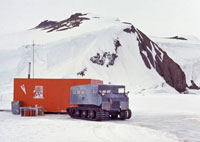
 |
||
 |
||
 |
||
 |
||
 |
||

HISTORY OF THE MCMURDO SOUND POPULATION STUDY, Page 3 |
The funding prospects that were available for this study at the onset determined, in large part, the approach to the ongoing study. The U.S. National Science Foundation funded all Antarctic science, and this continues today. The emphasis within NSF at that time was not focused on long-term efforts. Scientific endeavors were inclined toward experimental designs exploring specific hypotheses. Thus, any suggestion of investigating questions that could only be answered by long-term data sets, were looked upon as “monitoring” and were generally not favored during the review process. To continue with the Weddell seal studies it was essential to develop three year projects with specific hypotheses that could be pursued within that time frame. Thus, for the first ten years or so of this study, the major motivation was to fulfill these short term objectives and publish the results, with the general view that the more that was known about the individual seals that were used in study observations, the better the results would be. In 1973 the decision was made to tag all the Weddell seal pups born into the McMurdo population, as well as a significant number of adult females. From this time on, every three years, short term projects were outlined that would give The project stayed at the University of Alaska until 1993 when it returned back to the University of Minnesota. During this time, in all of these efforts the use of known-age individuals was extremely important. It was evident to everyone involved that the long-term data on individuals was becoming valuable to many different projects. During the period of the late 1990s and early 2000s the project began to consider the genetics of the population when Tom Gelatt began the molecular genetic work looking at how Weddell males differed in their contribution to the genetic pool, as well as considering the genetics of the small isolated group of Weddells that were located at White Island in the Ross Ice Shelf behind McMurdo station. Also during this time Michael Cameron worked with known-age animals to obtain age specific survival estimates as well as trying to further the understanding of the role that immigration plays in the overall dynamics of the McMurdo population. In 2002 the project moved to Montana State University with Bob Garrott and Jay Rotella as lead principal investigators. Since its arrival at MSU, the database has been subjected to analyses taking advantage of the fact that the McMurdo population database currently consists of over 80 percent known-age individuals. (For a description of our current project work please visit the Project section of this website.) More... |
Historical images courtesy Co-PI Don Siniff's Weddell project archive. |
Weddell seal images and recordings obtained under NMFS Permits 1032-1917 and 17236. Website copyright © 2015 WeddellSealScience.com. All rights reserved.
 publishable results, but within the framework of such projects the ongoing effort to tag pups and as many adults as possible was continued. By 1976 enough population data had accumulated so that an analysis of the population dynamics was completed by Siniff, and others. In 1988 the database and the continuing work to maintain the database moved to the University of Alaska with Ward Testa and Mike Castellini. They continued with the population work, but also used the known-age animals in reproductive and physiological studies. Again, the long-term work was nested within short term projects, including more recently focusing on physiology and movement patterns and foraging studies using satellite tags by Testa in 1994 and by Jen Burns and others in 1997.
publishable results, but within the framework of such projects the ongoing effort to tag pups and as many adults as possible was continued. By 1976 enough population data had accumulated so that an analysis of the population dynamics was completed by Siniff, and others. In 1988 the database and the continuing work to maintain the database moved to the University of Alaska with Ward Testa and Mike Castellini. They continued with the population work, but also used the known-age animals in reproductive and physiological studies. Again, the long-term work was nested within short term projects, including more recently focusing on physiology and movement patterns and foraging studies using satellite tags by Testa in 1994 and by Jen Burns and others in 1997.